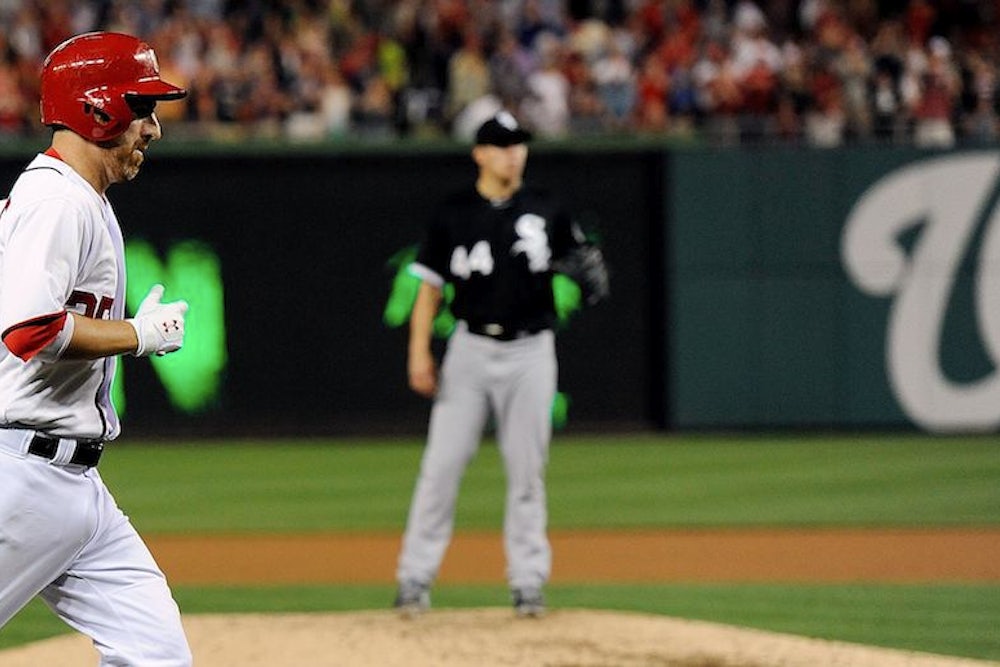On Tuesday night the Chicago White Sox, of the American League, were down three runs in the top of the ninth inning when closer Rafael Soriano, of the National League's Washington Nationals, gave up a two-run homer with two outs, bringing the tying run to the plate. That batter flew out, ending the game. Adam Dunn—Chicago's best power hitter, who in his 10 career plate appearances against Soriano has hit .500 with four walks, a double, and a home run—looked on helplessly from the on-deck circle, having received a grand total of zero at-bats. They were playing in Washington, after all, meaning that Dunn could not play his usual position: designated hitter, which exists only in the AL. White Sox manager Robin Ventura believed it smarter to sacrifice Dunn's bat in favor of another good glove in the field—probably a mistake, but it's a choice he hasn't had to make many times since 2010, when his team signed Dunn for $56 million over four years. In short, the Nats—who don't have to pay for a good-hitting, poor-fielding designated hitter1—had an advantage that may have won them the game. Good thing for the White Sox that it's only April.
Because pitchers hit in the NL and don't in the AL, teams in the two leagues in effect play significantly different games; and the players, managers, and executives of every franchise plan accordingly. Making an AL team go without a DH and (to a lesser extent) making an NL team adopt one puts them at respective disadvantages. (The rule is that pitchers hit when a game is played in an NL park and don't when one is played in an AL park.) This is why, until not long ago, the only times AL players faced NL players was the preseason, the All-Star Game, and the World Series—and why, when interleague play was introduced in 1997, each team's interleague games were limited to fewer than two dozen.
However, limiting interleague games actually aggravated the inequality, forcing teams in the same leagues and even divisions—that is, competing for the same titles and wild card spots—to play non-trivially different schedules. This year, perhaps to rectify this unfairness but more likely to boost attendance, the MLB is attempting something along the National Football League model, in which teams in the same division play teams from a matching division in the other the league. But differences in the numbers of teams per division and the inclusion of regional "rivalry games" guarantee a continued competitive imbalance.
This year brought another change that makes scheduling even more unfair. Previously, interleague play took place in June, July (before the All-Star Break), or late May. This year, it has been spread out from beginning to end: From the Los Angeles Angels of Anaheim's opening day tilt against the Cincinnati Reds last week through the Detroit Tigers' series at Miami (one of the best teams in the AL versus one of the worst in the NL, by the way) on the season's final weekend, there will be at least one interleague game essentially every day. While it is technically true that a win in early May counts the same as a win in late August, teams plan their seasons around finishing strong—and may make roster adjustments, including before the July 31 trade deadline, with that in mind. Therefore, forcing teams into interleague play near the end of the season creates another inequity.
There were always two prime arguments in favor of interleague play: that it allows yearly regional match-ups (Yankees-Mets, Dodgers-Angels, etc.), and that it's generally just a fun thing. For me, though, much of the novelty precisely involved its heavy concentration in one time period late enough that all 30 teams had firm identities, early enough that no game felt make-or-break. It was great to turn on "Baseball Tonight" on a warm spring night and see the results of Cardinals-Royals or Orioles-Phillies and to know that this would be the case only for the next two weeks, and that by September it would be all business. This year, while there are a couple of very short blocks of more widespread interleague games (particularly over Memorial Day weekend), it won't be the same.
We can argue over the merit of the designated hitter and over the merit of one league having it and the other league not.2 But it is inarguable that it would be easier to tinker with—or eliminate—interleague play than to deal with the DH, which to baseball purists (on both sides of the argument) is something like a third rail.
As a Nationals fan, I was happy about Tuesday night's "curly W," but imagine I'll be less happy when it's the end of July, the playoff race is heating up, and the Nats will play the talented Tigers in Detroit—and therefore at their own game—while knowing that the divisional rival Mets and the Phillies get, according to Baseball Prospectus, the two easiest interleague schedules this season. If there is one thing other sports leagues can learn from the general administrative mess known as the NFL, it is that the bosses should encourage competitive parity. This new style of interleague play, by contrast, hurts parity and detracts from part of what made interleague play enjoyable anyway. In short: Apart from New York tabloid writers who love a good "Subway Series" pun, would anybody miss interleague play if it went the way of the dead ball?
In 2010, in fact, they chose not to re-sign a good-hitting, poor-fielding first baseman named Adam Dunn.
From the players' perspective, having the DH probably leads to overall higher payrolls. For what it's worth, as a onetime committed fan of an AL team and a present committed fan of an NL team, I vastly prefer the DH-less NL game.
